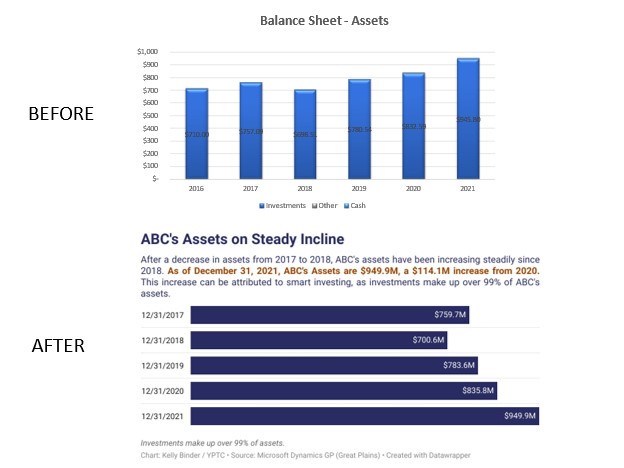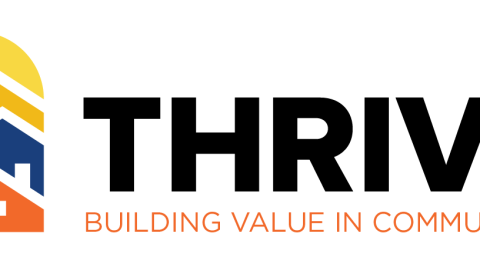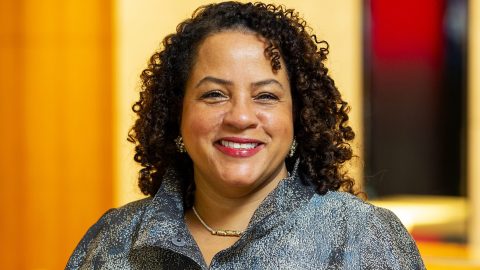
A museum’s financial reports must be crafted and communicated in ways that engender trust and strategic decision-making.
This article originally appeared in Museum magazine’s May/June 2025 issue, a benefit of AAM membership.
Imagine this scenario: you’ve just begun to give the finance report at your museum’s board meeting, and you need to explain why expenses in one area are so much higher than budgeted. This variance is a normal part of your museum’s annual budget cycle, and you have prepared a second spreadsheet to provide context. But as you scan the room, you are greeted with glazed looks instead of nods of approval or comprehension. Your board members are lost in your reports, which to them are just abstract numbers. The finance discussion ends without any real discussion. Your board members’ lack of financial comprehension means they are unable to meet one of their core responsibilities.
Sound familiar? As a museum leader, you’re not just responsible for managing operations, leading development efforts, and overseeing the programs, projects, and employees that enable your museum to meet its mission. Today’s museum leaders must be skilled financial communicators. They must be able to work with their finance teams to produce timely and accurate financial data and then share the story those numbers tell in a way that helps management teams and board members make proactive and strategic decisions.
Building a Strong Financial Partnership
Like individual artists collaborating on a large studio project, the museum leader and the financial team need to work toward a common goal of effective financial management. This partnership extends beyond monthly reporting: it’s an ongoing dialogue that shapes what financial information flows through the entire organization and how it does so, ultimately ensuring everyone on the museum’s staff and board understands how strategic goals relate to financial goals. When this partnership is characterized by clarity and trust, everyone in the organization can fulfill their roles.
Museum leaders who build strong partnerships with their financial teams gain a deeper understanding of their institution’s financial picture, which helps them make informed decisions that support the overall mission and vision. This collaboration also helps identify potential challenges before they become problems and highlights opportunities that might otherwise be missed. For example, a museum director expecting a cashflow shortage months in advance can alert the board and, if necessary, arrange a line of credit. A management team aware of a strong cash position may speed up investment in a strategic project.
The most effective leader–finance team partnerships typically include:
- regular strategy sessions that go beyond reviewing numbers and use financial reports as tools for achieving mission-related goals;
- candid, open-ended discussions about challenges and opportunities;
- collaborative development of financial reports and dashboards;
- joint presentations to the board and other stakeholders;
- shared responsibility for financial literacy training across the organization.
By fostering this crucial relationship, museum leaders create a foundation for financial clarity that supports every aspect of museum operations and strategic planning. Financial reports are not abstract sets of numbers but tools that help everyone reach strategic goals.
Different Stakeholder Needs
Success starts with timely and accurate financial data. Museums struggling to produce timely reports might consider bringing in outside expertise to help refresh systems and educate staff. But data literacy is just the foundation. The real work begins in transforming those numbers into compelling stories that resonate with different audiences and drive informed decision-making. While financial reports must be accurate and timely, their presentation should be clear and visually engaging.
The key to this transformation lies in understanding that different stakeholders need different levels and types of financial information. Board members need high-level strategic metrics tied to mission impact. Department heads require detailed operational data. Development teams need donor-centric financial narratives. Finally, the public deserves transparent, accessible financial information that builds trust.
When developing a financial communication strategy, consider these essential questions:
- Who is the audience for each report?
- What information do they need, and what decisions will they make based on it?
- What is their level of financial literacy, and what formats or features best suit them (narrative, visual, numerical, or a combination)?
- Do you have clear guidelines on how to record and share financial information with different audiences?
Determining Your Financial Benchmarks
There is no one-size-fits-all approach to financial reporting. What works for a small historical society won’t necessarily serve a large art museum. For many museums, tracking visitor numbers (and the earned revenue associated with them) is key. For others, tracking state grants or philanthropic donations is more important than entrance fees and shop sales. There is no one “right” metric, so start by identifying the specific trends, key performance indicators (KPIs), and benchmarks that matter most to your institution.
Here are some areas to consider:
Context
- What do other museums in your discipline measure? What about institutions with a similar budget size, regardless of their discipline? Similar footprint or facility? Collecting vs. non-collecting? Endowed vs. not endowed?
- What role does location play? Things to consider: seasonal/climate trends; proximity to public transportation; tourist vs. local visitor patterns; competition from other cultural attractions; parking availability; and neighborhood safety and accessibility.
- Who are your audiences, and what are their habits? Things to consider: cultural differences; schoolchildren vs. seniors; family groups vs. individual visitors; international vs. domestic tourists; frequent vs. first-time visitors; weekday vs. weekend preferences; digital engagement levels; average length of stay; and preferred visiting hours.
Mission and Impact
- How do you measure success in achieving your core mission?
- Which programs most directly advance your mission objectives?
- Do your programs reflect the needs identified by your community?
- What metrics demonstrate your community impact?
- Do your staff, board, and visitor base reflect the demographics of your community?
Financial Health
- What indicators demonstrate you’re spending money wisely, or building financial sustainability?
- How do you measure the effectiveness of your fundraising efforts?
- What early warning signs portend potential financial challenges for your institution?
Align Mission with Money
Each museum must choose key performance indicators that suit its unique circumstances, including those related to financial metrics, program impacts, or visitor engagement. But measurement alone is not enough. A museum leader’s most crucial role is ensuring that every strategic initiative aligns with both the mission and the financial reality—not just aspirations—of the institution. This means that the strategic plan, annual budget, program initiatives, and financial outcomes must all work together. There’s an old saying: “A strategic plan without a financial plan is just wishful thinking.”
By their nature, museums have more complex financial considerations than many other nonprofits. They may own or lease facilities that require expensive maintenance. They may have visitation so robust it ironically becomes detrimental to their historic surroundings (or at the very least puts their climate control systems to the test). Many museums own collections, and these come with challenges—interpretation and display, conservation, provenance research and potential repatriation, insurance, loans, copyright laws, deaccessioning, capitalization, and more—that can have financial ramifications.
Once the museum leader and finance team have established relevant KPIs to share with various stakeholders, all departments should ground their programs in the financial reality. This does not mean finance should stifle innovation or require every program to turn a profit. Some programs may function as “loss leaders,” advancing the mission despite operating at a financial loss. However, financial awareness should guide sustainable innovation.
Balancing museum-wide goals becomes more manageable when finance teams and museum leaders partner on tailored reports for different stakeholders. This can help different museum departments work toward a common goal, align management and the board in their purpose, facilitate productive relationships with museum communities, and ultimately help the museum meet its mission and vision.
As museums face increasingly complex financial challenges, museum leaders must strike a delicate balance between financial acumen, communication skill, and strategic vision. The good news? Museum leaders don’t have to do this alone. By building strong partnerships with finance teams, board treasurers, and external advisors, museum leaders can strengthen their ability to lead with financial clarity.
Remember, the goal isn’t just to present numbers—it’s to empower stakeholders with financial understanding. Clear, strategic financial communication enables confident, mission-aligned decisions that sustain and advance your museum’s mission, impact, and long-term success.
Tell Better Stories with Your Data
A good graph or chart does more than just summarize quantitative information; it tells a clear and concise story about the data. Think of it like a short newspaper article: the reader should be able to get the main idea from the headline, understand the context from the body copy, and see how data points in the visualization relate to each other.
The first image below is an all-too familiar column chart: generic, lacking in detail, and without a clear takeaway message. The revamped bar chart beneath it presents the same information in a much more impactful and reader-friendly way.
Improvements made:
- Changed the generic title to a descriptive headline that states the most important point.
- Added crucial context with a short interpretation of the data.
- Simplified the chart by going back five years instead of six.
- Graphed total assets instead of breaking them into different categories, which are illegible. Instead, referred to asset breakdown in the interpretation and a note below the chart.
- Made data labels clear and reduced visual clutter by removing the legend, which was no longer necessary.
- Toned down color and used ABC’s brand colors.
- Added the data source and byline.

Financial Leadership Checklist
✓ Essential Prerequisites
- Establish systems for timely, accurate financial reporting.
- Define clear roles and responsibilities within the financial team.
- Create a financial literacy training program for board and staff.
✓ Building Your Dashboard
- Identify five to seven key metrics that truly matter for your institution.
- Design visual representations of complex financial data.
- Create different versions for different audiences.
✓ Communication Strategy
- Schedule regular financial updates with key stakeholders.
- Develop a clear escalation process for financial concerns.
- Create templates for consistent financial storytelling.
✓ Strategic Alignment
- Link every strategic goal to financial implications.
- Develop clear success metrics for new initiatives.
- Regularly review and adjust financial targets.







